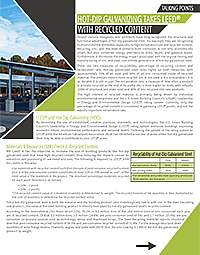Project owners, designers, and architects have long recognized the structural and functional advantages of hot-dip galvanized steel. Increasingly, they are recognizing its environmental attributes, especially its high reclamation rate and recycled content. Recycling zinc, and the steel it protects from corrosion, is not only economically smart, but also conserves energy and reduces solid, liquid, and gaseous waste. Furthermore, it distributes the energy impact associated with the original mining and manufacturing of zinc and steel over infinite generations of hot-dip galvanized steel.
There are two measures of recyclability, percentage of recycling content and reclamation rate. Hot-dip galvanized steel rates highly on both measures, with approximately 70% of all steel and 30% of all zinc consumed made of recycled material. The primary reason more recycled zinc is not used is it is unavailable - it is so durable it is still in use! The reclamation rate, a measure of how often a product is actually recycled at the end of its useful life, is even higher for both, with virtually 100% of structural and plate steel and 80% of zinc recycled into new products.
The high interest in recycled material is primarily being driven by individual environmental awareness and the U.S. Green Building Council's (USGBC) Leadership in Energy and Environmental Design (LEED®) rating system. Currently, only the percentage of recycled content is considered in garnering LEED® points, and not the equally important reclamation rate.
Created in 2009 as part of a Talking Points series to educate legislators and the general public about hot-dip galvanized steel, this one-page handout discusses the recyclability of zinc and steel. The publication also details the LEED® rating system and what credits hot-dip galvanized steel can contribute.



